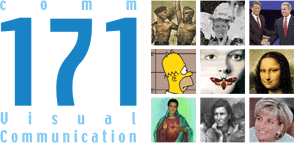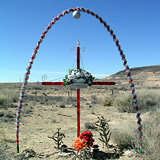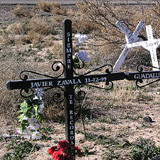
Office: HGH 210; phone: (408) 924-5378
Email: wooda@email.sjsu.edu
Web: http://www.sjsu.edu/faculty/wooda
 |
Dr. Andrew Wood Office: HGH 210; phone: (408) 924-5378 Email: wooda@email.sjsu.edu Web: http://www.sjsu.edu/faculty/wooda |
Reading:
Blair, C., Jeppeson, M.S., & Pucci, E. (1991). Public memorializing in postmodernity: The Vietnam veterans memorial as prototype. Quarterly Journal of Speech, 77(3), pp. 263-288.
| Note: These comments are not designed to "summarize" the reading. Rather, they are available to highlight key ideas that will emerge in our classroom discussion. As always, it's best to read the original text to gain full value from the course. |
Mircea Eliade argued that all civilizations develop means to differentiate between spaces defined as sacred and those defined as profane. The built environment contains sites that teach us to tell the difference. As an example, consider the roadside shrine to lost loved ones killed in car accidents. These monuments call attention to particular lives, specific places. In "the middle of nowhere," they call for us to sanctify places we might otherwise ignore.
 |
 |
From the perspective of rhetoric, these sites may be termed epideictic; they teach and affirm values of public life. In U.S. society, monuments represent a form of epideictic rhetoric by conveying what values and persons should be defined as heroic and/or sacred. However, the Vietnam Veterans Memorial in Washington D.C. challenges many traditional notions of monumental design, inviting us to consider larger questions of modernity and postmodernity, and whether contemporary life can contain heroic notions any longer. Here, you might visit a page I developed for my course, Communication in the Age of Mobility, that describes the changing natures of history and heroism in the imagination of monuments. At this point, two key terms must be explored anew.
• Modernity may be defined as a metanarrative defined by its break from history and its celebration of technology, efficiency, functionality, and “the new.”
• Postmodernity may be partially defined as a persuasive act that rejects metanarratives, particularly the metanarrative of modernism: “Its refusal of a single, signature style and its reliance on multiple, sometimes conflicting genres defy reference to singular standards of judgment” (p. 266). Within postmodern architecture, one finds multiple and partial references to various pasts and regional vernaculars: “To attempt a unified, centered reading, thus, is to miss the point” (p. 269).
The authors shift from this discussion to explore the degree to which modernity or postmodernity can commemorate individual achievements. They note that modernity might approach such sanctification of history as superfluous while postmodernity would likely question the choice of which narrative to sanctify. Even so, the authors' analysis of the Vietnam Veterans Memorial illustrates a potential of postmodern monumental architecture to exist and provide a more humanely epideictic rhetoric. They emphasize the following components of the Memorial as being postmodern:
• Mutability: illustrated as people “alter [the monument's] symbolic field” through the addition of artifacts and their own mirrored images on the polished granite (p. 272)
• Collectively-authored text: the "designs, when juxtaposed, alter one another's rhetoric substantially, thus restricting the designers' ability as authors to interpret or account for their own work" (p. 273)
• Non-linear text: illustrated by the "circle" of names
• Human scale: "It does not dominate the landscape but respects it. Too, it is accessible to [and touchable by] visitors" (p. 274)
• Political stance: "Questioning is the point, and that point is a thoroughly political one" (p. 275)
• Contested meaning: illustrated by the varied meanings of the wall and the statue[s]: "To contemplate one, a visitor must turn his/her back on the other" (p. 277)
• Non-monolithic, non-heroic: "the unity disintegrates in the face of the symbolic potency of each name" (p. 278)
The authors conclude
by summarizing postmodern monuments as requiring (a) multiple stories marked
by the possibility of both-and rather than either-or interpretations and (b)
an emphasis on humanity more than the structure of the site. In the final pages,
they offer their analysis as a way to encounter other texts beyond those of
architecture.
Off-campus webpages
World Trade Center Site Memorial Competition: Reflecting Absence <http://www.wtcsitememorial.org/fin7.html>
Note: These pages exist outside of San Jose State University servers and their content is not endorsed by the page maintainer or any other university entity. These pages have been selected because they may provide some guidance or insight into the issues discussed in class. Because one can never step into the same electronic river twice, the pages may or may not be available when you request them. If you have any questions or suggestions, please email Dr. Andrew Wood.